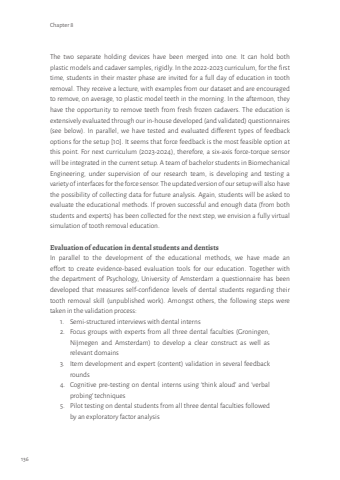Page 138 - Demo
P. 138
Chapter 8136The two separate holding devices have been merged into one. It can hold both plastic models and cadaver samples, rigidly. In the 2022-2023 curriculum, for the first time, students in their master phase are invited for a full day of education in tooth removal. They receive a lecture, with examples from our dataset and are encouraged to remove, on average, 10 plastic model teeth in the morning. In the afternoon, they have the opportunity to remove teeth from fresh frozen cadavers. The education is extensively evaluated through our in-house developed (and validated) questionnaires (see below). In parallel, we have tested and evaluated different types of feedback options for the setup [10]. It seems that force feedback is the most feasible option at this point. For next curriculum (2023-2024), therefore, a six-axis force-torque sensor will be integrated in the current setup. A team of bachelor students in Biomechanical Engineering, under supervision of our research team, is developing and testing a variety of interfaces for the force sensor. The updated version of our setup will also have the possibility of collecting data for future analysis. Again, students will be asked to evaluate the educational methods. If proven successful and enough data (from both students and experts) has been collected for the next step, we envision a fully virtual simulation of tooth removal education. Evaluation of education in dental students and dentistsIn parallel to the development of the educational methods, we have made an effort to create evidence-based evaluation tools for our education. Together with the department of Psychology, University of Amsterdam a questionnaire has been developed that measures self-confidence levels of dental students regarding their tooth removal skill (unpublished work). Amongst others, the following steps were taken in the validation process:1. Semi-structured interviews with dental interns2. Focus groups with experts from all three dental faculties (Groningen, Nijmegen and Amsterdam) to develop a clear construct as well as relevant domains 3. Item development and expert (content) validation in several feedback rounds4. Cognitive pre-testing on dental interns using ‘think aloud’ and ‘verbal probing’ techniques5. Pilot testing on dental students from all three dental faculties followed by an exploratory factor analysisTom van Riet.indd 136 26-10-2023 11:59


